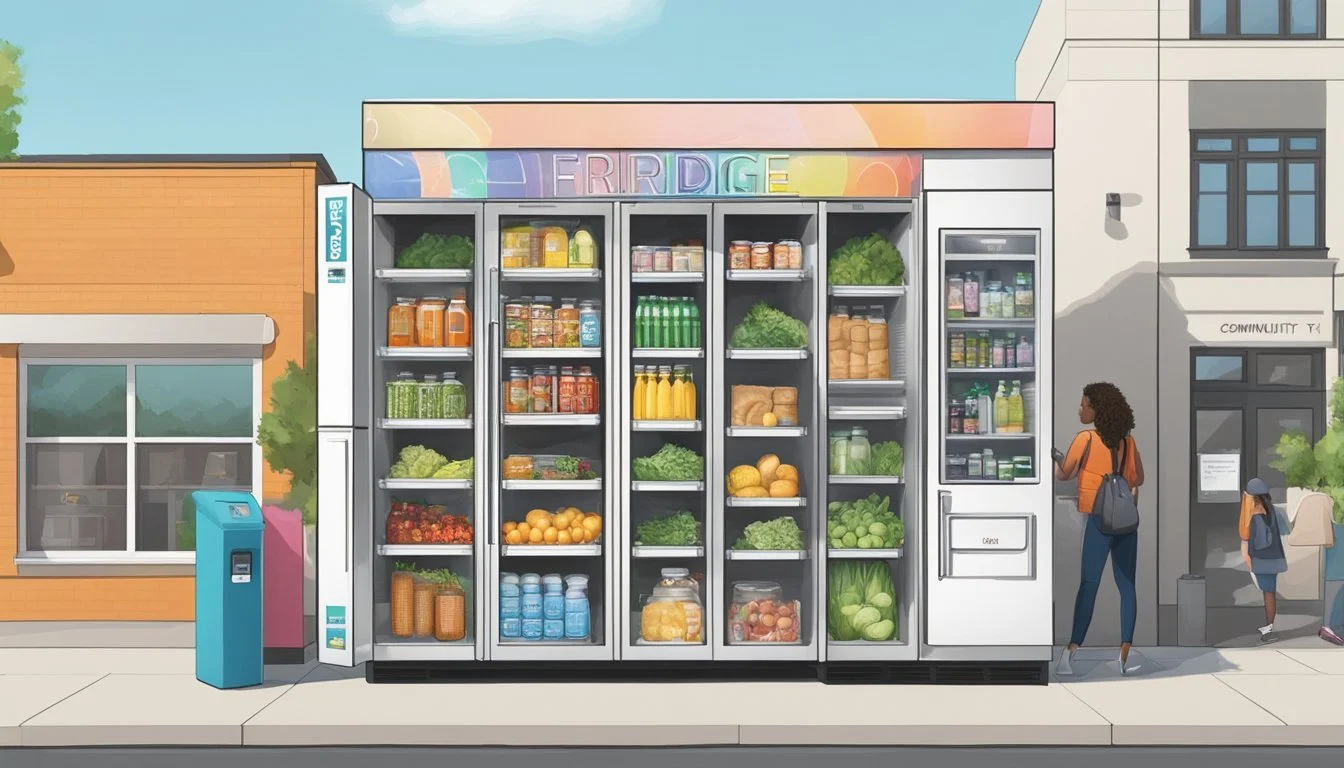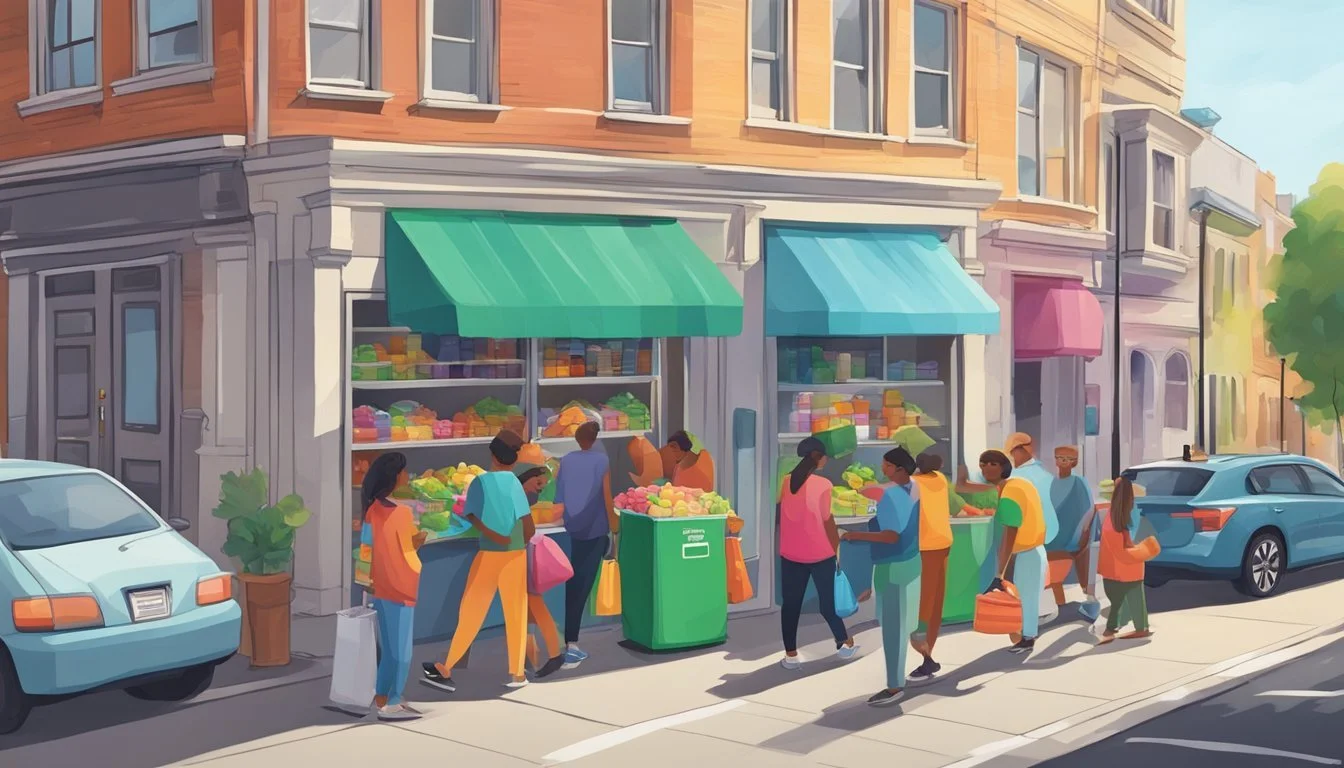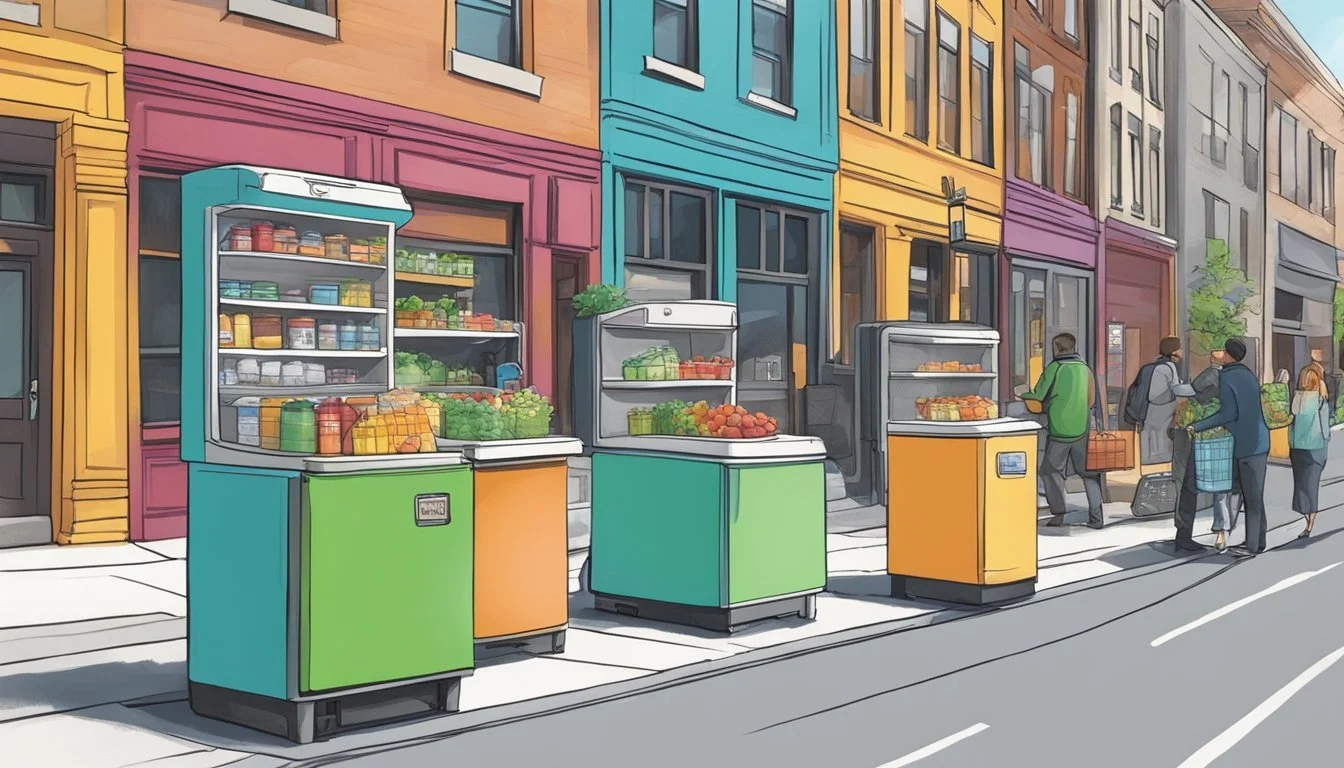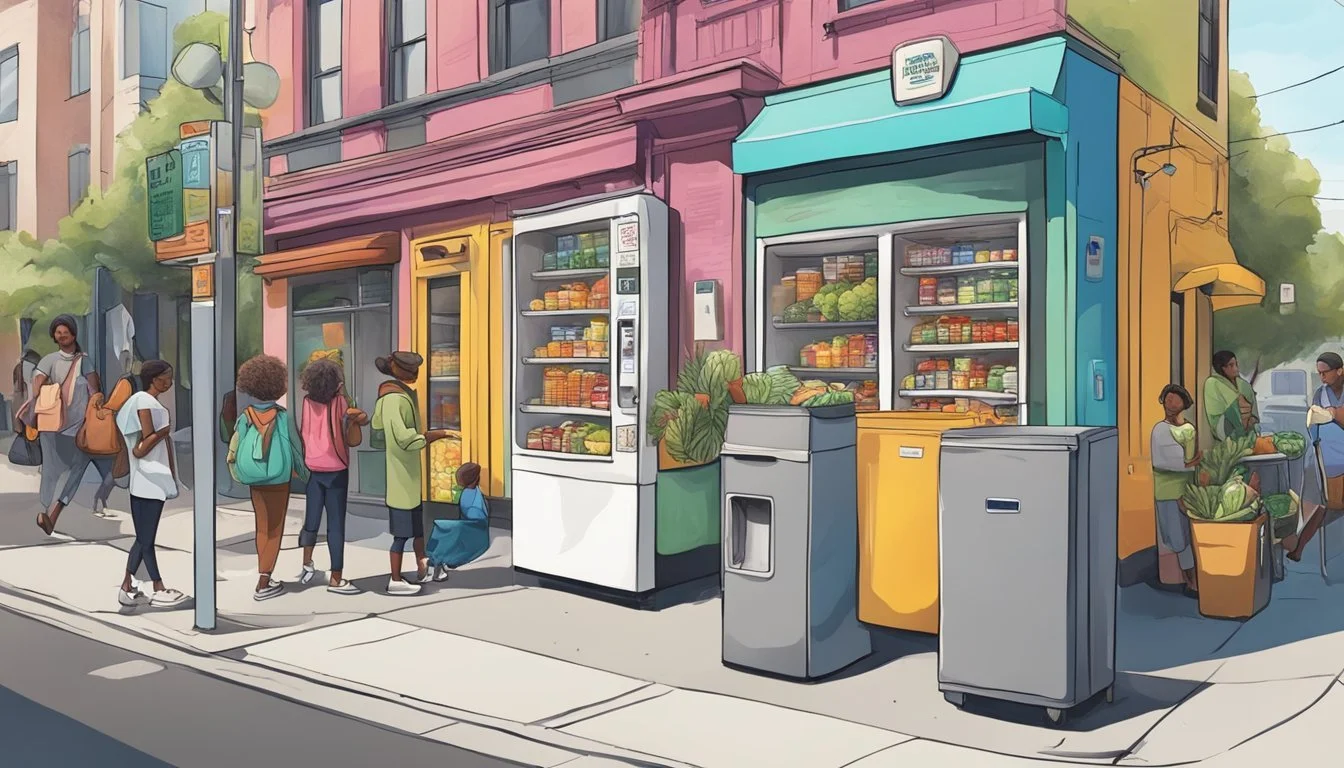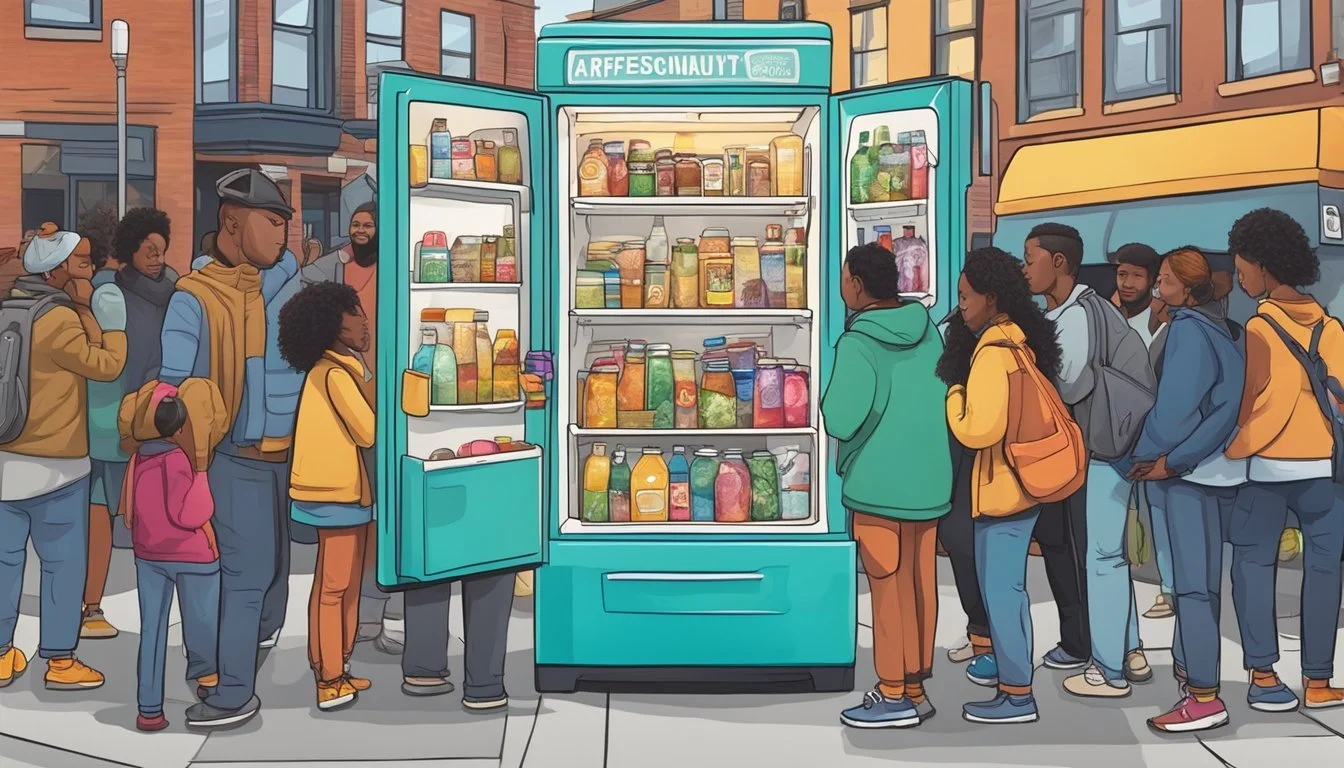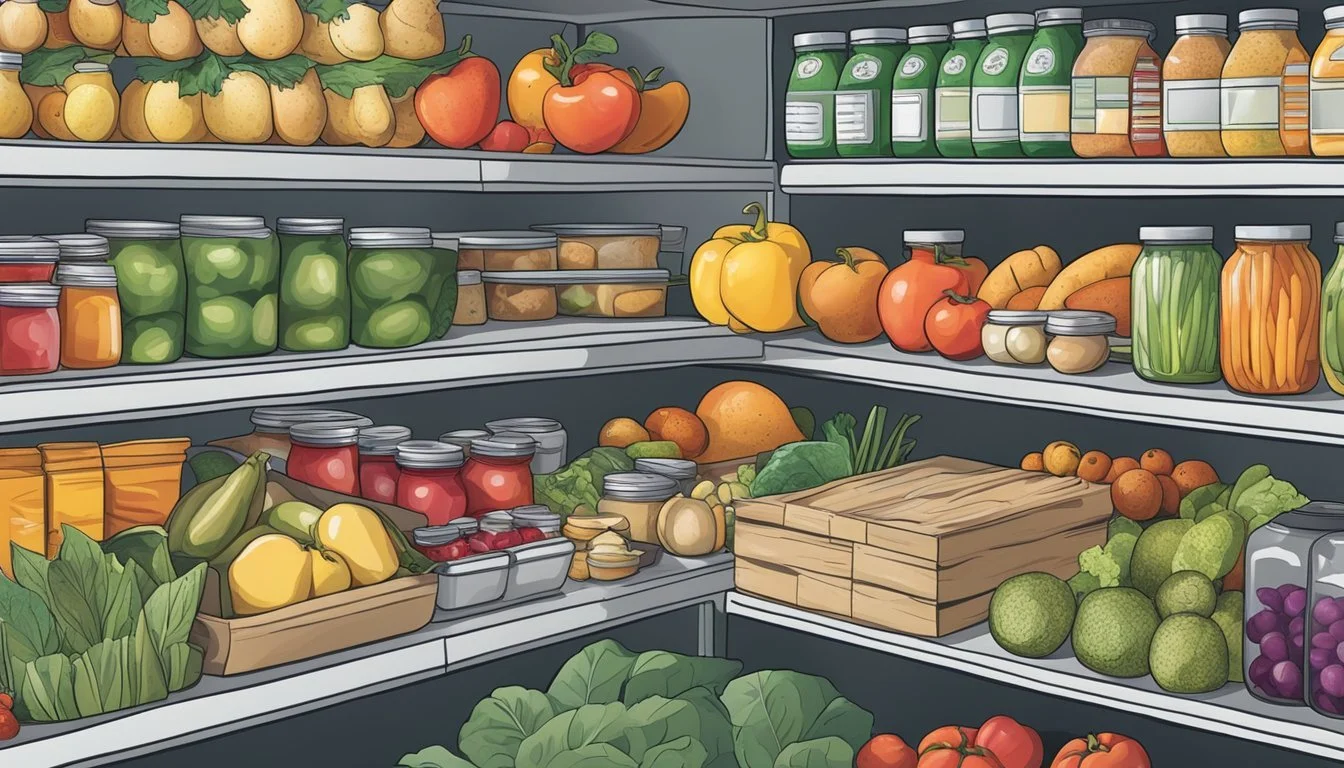Indianapolis, IN Community Fridge
Tackling Food Insecurity with Sharing Initiatives
In Indianapolis, the concept of community fridges serves as a beacon of mutual aid and food security, embodying a simple, yet effective form of grassroots support. These refrigerators, placed strategically throughout the city, provide free, healthy food to anyone in need. Managed by volunteers and powered by donors, the fridges are a testament to the power of community solidarity and the fight against hunger. They operate on the principle that access to nutritious food is a right, not a privilege, aiming to bridge the gap in food deserts and alleviate the burdens of food insecurity.
Indianapolis's network of community fridges, often adorned with unique artwork, has emerged as a crucial resource for residents facing economic hardship. The initiative not only focuses on providing immediate relief but also fosters a stigma-free environment that encourages individuals to take what they need without judgment. They are typically filled with fresh produce and other perishables, which are regularly checked and maintained by volunteers to ensure safety and freshness.
The impact of these community fridges in Indianapolis extends beyond mere sustenance, reinforcing the collective responsibility towards the well-being of neighbors. By enabling easy access to food, these fridges have carved out spaces of hope and support within the cityscape. They stand as symbols of communal empathy, showcasing what can be achieved when residents come together to support one another in times of need.
Concept and Purpose
The Indianapolis Community Fridge initiative serves a dual purpose: providing access to nutritious food while combating food wastage. This approach reflects a broader commitment to mutual aid and environmental sustainability within the local community.
Addressing Food Insecurity
Indianapolis has implemented community fridges to tackle food insecurity by offering free food access to individuals in need. These fridges facilitate an environment of sharing, where community members can donate and receive fresh and healthy food. Establishments are strategically placed to ensure ease of access, making sure that no one is left out of this loop of generosity.
Reducing Food Waste
Besides providing aid, these fridges play a significant part in reducing food waste. By encouraging food donations, they help in rerouting excess food that might otherwise be discarded to individuals who can benefit from it. The concept of the community fridge is not just about food distribution but also about instilling a sustainable food culture among community members. It highlights an important message of utilization over waste.
Implementation in Indianapolis
The introduction of community fridges in Indianapolis represents a significant step by local organizations to tackle food insecurity within the city. These initiatives invite a sense of community partnership and demonstrate adaptability during crises such as the COVID-19 pandemic.
Local Initiatives
Indianapolis has witnessed the emergence of various local initiatives aimed at addressing food disparities among its residents. An example is "Love Fridge Indy," an entity which operates a community refrigerator collective. They obtain donated refrigerators and make them publicly accessible, allowing individuals to donate or take food as needed. This grassroots effort epitomizes the local community's response to hunger and food scarcity.
Indy Community Pantry is another pivotal initiative. They operate mini food pantries and refrigerators across the city, supplementing efforts under challenging circumstances like the COVID-19 pandemic. Partnerships between organizations like Gleaners Food Bank and the City of Indianapolis further amplify this support network through mobile pantries, particularly in neighborhoods with sparse food access.
The Community Food Box Project provides additional support by offering food to those impacted by grocery store closures, demonstrating the city's resilience and commitment to feeding those in need.
Freedge Movement
The "freedge" initiative, also known as community fridges, is not unique to Indianapolis but is part of a wider global movement to promote free food accessibility. These community-run refrigerators not only serve as food sources but also act as symbols encouraging mutual aid and collective well-being within urban environments. They are stocked with donations from community members, local businesses, and sometimes even farmers, providing fresh, healthy food to anyone without restriction. This movement gains relevance against the backdrop of the COVID-19 pandemic, indicating the importance of community resilience and the initiative's adaptability to ongoing societal challenges. The enduring spirit of the freedge movement within Indianapolis is a testament to the city's commitment to food solidarity.
Location and Accessibility
Community fridges in Indianapolis provide an innovative solution to address food insecurity while promoting sustainability. These fridges are strategically situated to offer convenient access to residents seeking free, healthy food options or looking to contribute donations.
Finding the Fridge
In Indianapolis, community fridges are usually located in neighborhoods where access to fresh food is limited. The initiative, known as Love Fridge Indy, places these communal refrigerators in areas that are easily accessible to the public. Residents can find these fridges in prominent community spaces, like local businesses or community centers, that have partnered with Love Fridge Indy. The exact locations of these fridges can typically be discovered through community networks, social media pages, or local resources dedicated to the project.
Operating Hours
Community fridges operate on the principle of 24/7 accessibility to ensure that everyone has the opportunity to obtain food outside of traditional pantry or grocery store hours. This round-the-clock availability caters to the varying schedules and needs of the Indy community, allowing individuals to either donate or take food at their convenience. It's important to note that while the fridges are accessible at any time, the amount and variety of available food may vary throughout the day depending on contributions from the community.
Participation and Usage
The Community Fridge initiative in Indianapolis allows for straightforward participation from all community members. People looking to support the community can donate food, while those in need have the liberty to take food without any barriers to access.
How to Donate
Individuals wishing to contribute to the Community Fridge can do so by donating fresh produce and other food items. Donations must meet safety standards and should be unopened and within their use-by dates. The process is designed to be inclusive and hassle-free, encouraging widespread participation.
Acceptable Donations:
Fresh fruits and vegetables
Packaged and sealed foods
Non-perishables
Who Can Take Food
Community fridges are openly accessible to all community members in need. There are no prerequisites for individuals to fulfill when taking food from these fridges, ensuring that assistance reaches those who need it without stigma or judgment.
Food Accessibility:
Available 24/7
No forms or ID required
Take as needed, while being mindful of others
This approach promotes a collective effort to support and sustain the community, making food more accessible, reducing waste, and fostering communal support.
Community and Partnerships
The success of the Indianapolis Community Fridge initiative hinges on strategic collaborations and robust support from local organizations, ensuring that the local community benefits from these efforts. This network thrives as a non-profit entity, deeply rooted in and supported by the strength of its partnerships.
Local Collaborations
In Indianapolis, grassroot collectives such as "Love Fridge Indy" epitomize local collaboration. They bring together community members who donate and maintain refrigerators, strategically placing them in neighborhoods to alleviate food insecurity. These partnerships are fundamental, as refrigerators become nodes of communal support where residents donate food or take what they need free of charge.
Support from Organizations
Non-profit initiatives like the Indy Community Pantry highlight the impact of organizational support. They have expanded their services to include vegan options in their community refrigerators, addressing diverse dietary needs. Moreover, these organizations attract partnerships that help them sustain and install community food boxes, illustrating the non-profit sector's role in driving these community-focused efforts forward.
Covid-19 Pandemic Response
During the COVID-19 pandemic, community fridges in Indianapolis became a crucial asset in addressing food insecurity. These fridges, often referred to as "Love Fridge Indy," supplied free and healthy food.
Safety Measures
To ensure the health and safety of the community, organizers implemented stringent safety protocols for fridge maintenance. Sanitization stations with hand sanitizer and disinfecting wipes were placed near fridges and regular cleaning schedules were enforced. Volunteers wore masks, and signage with safety guidelines was displayed prominently. The measures abided by CDC guidelines for preventing virus transmission through frequently touched surfaces.
Community Support Amidst the Pandemic
The community fridges embodied the local response to surging needs during the pandemic. They operated on a simple principle: those with extra could leave food and those in need could take it. This mutual aid system was particularly potent during the economic strain caused by the coronavirus pandemic. The Indy Hunger Network played a key role, revealing that while the availability of food assistance doubled, so did the need, underscoring the importance of these fridges in the crisis.
Additional Resources and Information
This section offers contact details for support and a selection of reading materials for those interested in the Community Fridge initiative in Indianapolis.
Contact and Support
To get involved or seek assistance from the Community Fridge Indy program, individuals can reach out through their main contact channels. They typically offer email support and may have volunteer coordinators available to manage community contributions and inquiries. For those looking to contribute, food donations can be directed to designated fridge locations throughout Indianapolis.
For broader support related to food insecurity, Feeding America is a nationwide network that provides assistance. Their contact information can be accessed through the Feeding America website, with specific details for local food banks and support systems.
Further Reading
For a deeper understanding of food assistance programs, there are several resources:
Local Newspapers like the IndyStar provide coverage on grassroots efforts like Indy Community Pantry and can offer insights into the community impact.
Official websites for programs like SNAP and WIC contain comprehensive information on governmental assistance options.
The ChangeX website is a hub for those looking to start or join local community fridge initiatives, providing resources and guidance.
Readers are encouraged to review these resources to gain a comprehensive view of the community efforts and the various ways they can participate or receive support.
Impact and Future Outlook
The Indianapolis Community Fridge initiative demonstrates a tangible approach to mitigating food insecurity and promoting environmental sustainability.
Environmental Contribution
Community fridges in Indianapolis are actively contributing to environmental conservation by reducing food waste. Excess food that would otherwise be discarded is now redirected to these fridges, affording individuals in need access to fresh, healthy options. The initiative also complements recycling efforts, as community members are encouraged to use reusable containers and environmentally friendly packaging when donating food items.
Community Fridge Expansion
The expansion of community fridges across Indianapolis points to a promising future in fostering community resilience. The growth in the number of fridges indicates an increase in both the awareness of food inequality and the willingness to combat it. Future outlooks suggest that these fridges will not only continue to serve as a resource for those facing food scarcity but may also become integral to larger systems of food pantries and shelters, optimizing the distribution of food resources throughout the city.
Profiles and Stories
In the heart of Indianapolis, community fridges emerge as symbols of hope and solidarity, where local heroes and success stories unfold every day.
Local Heroes
The Founder: At the forefront of the Love Fridge Indy initiative is a founder whose vision for a healthier community catalyzed a movement. This individual, whose grassroots efforts echo throughout the city, has inspired countless residents to contribute to a sustainable solution to food insecurity.
Community Members: Volunteers and local artists breathe life into the project. Artists transform refrigerators into colorful beacons, while residents ensure these community fridges are stocked and maintained. Such collaboration fosters both a sense of community and a practical response to a pressing issue.
Success Stories
Feeding Families: Every stocked fridge represents a success story, each item of fresh produce or healthy food a paragraph in an unwritten chapter about a family's nourishment.
Eradicating Hunger Pangs: One fridge at a time, the Indy Community Pantry micro-pantries have surfaced as triumphs over hunger. Miniature repositories of hope, they stand as testaments to what a community can achieve when it unites for the common good.
Health and Nutrition
Community fridges in Indianapolis are providing free, healthy food options, aiming to improve food accessibility and nutrition education in the area. They emphasize the importance of fresh produce and nutritious offerings to support a healthy lifestyle.
Benefits of Healthy Options
Community fridges, like Love Fridge Indy, are crucial in offering healthy food options to the Indianapolis public. These fridges are stocked with a selection of fresh produce, ensuring that individuals and families have access to fruits and vegetables, which are essential for a balanced diet. The presence of these fridges in neighborhoods makes it convenient for community members to incorporate healthy foods into their daily meals.
Accessibility: Easy access to nutritious foods.
Variety: A range of fresh, wholesome ingredients.
Education on Nutrition
In addition to providing healthy food, these initiatives also serve as a platform for nutrition education. They help raise awareness about the benefits of healthy eating and guide community members on how to prepare balanced meals. Through educational programs and resources, individuals learn to make informed choices about their diet, aligning with the initiatives' goals to fight food insecurity and promote health.
Information: Educational materials on dietary health are often available.
Workshops: Some programs may host events to teach meal preparation and nutrition.
Technological Advancements
In Indianapolis, the implementation of community fridges utilizes advanced technology to enhance food accessibility, emphasizing the integration of smart fridges and meticulous food tracking systems for optimal safety and efficiency.
Smart Fridge Innovation
Community fridges in Indianapolis have embraced smart technology to provide free, healthy food options to the public. These smart fridges are not traditional refrigeration units; they are equipped with features such as digital temperature monitoring, remote locks, and inventory management systems, ensuring that the stored items remain fresh and secure for those in need. Essentially, smart fridge technology parallels the sophisticated systems found within high-tech vending machines, offering a user-friendly interface and automated inventory control.
Food Tracking and Safety
The safety and tracking of food in community fridge initiatives rely heavily on modern technology. Each fridge integrates software for food tracking, which logs details like the type and quantity of food available, as well as expiration dates. This system ensures the following through transparent reporting:
Food Freshness: Real-time updates keep food items within safe consumption periods.
Inventory Levels: Adjustments can be made based on the supply and demand metrics.
Safety Alerts: In case of temperature deviations or expired products, alerts are dispatched to administrators for immediate action.
By leveraging such systems, community fridges in Indianapolis maintain high standards of food safety, mirroring the accountability seen in commercial food technology applications.
Financial Aspects
The financial sustainment of the Indianapolis Community Fridge initiative requires strategic cost management combined with robust fundraising efforts to maintain its operation.
Cost Analysis
The costs associated with running a community fridge in Indianapolis include purchasing the refrigerator units, paying for continuous electricity to operate the fridges, and ensuring regular maintenance and cleaning. Expenditures also cover necessary insurance and potential repair work that might be needed over time. A simplistic breakdown of initial costs might look like this:
Refrigerator Unit: $500 - $1,500 each
Electricity: $15 - $30 per refrigerator per month
Maintenance and Cleaning: Variable, dependent on condition and usage
Insurance and Repairs: Variable, potential monthly set-aside of $10 - $20
These costs are met through donations and support from the local community.
Fundraising and Support
Fundraising for the Indianapolis Community Fridge is conducted through various channels:
Monetary Donations: Individuals and organizations can make one-time or recurring contributions.
Local Business Sponsorships: Partnerships with local businesses provide a steady influx of funding and often include sponsorships in kind, such as providing electrical work or maintenance.
In-kind Support: This includes the donation of actual refrigerators, volunteer time for fridge monitoring and restocking, and provision of food items. A list of needs is often circulated to garner community support, emphasizing the donation of healthy and fresh food items to stock the fridges.
Related Movements
Community fridge initiatives in Indianapolis are part of a larger, growing movement across the United States and internationally, aimed at addressing food insecurity and reducing food waste through grassroots efforts and mutual aid.
National Community Fridge Networks
In the United States, several cities have established their own community fridge networks to combat hunger and food waste. For example, Detroit Community Fridge operates with a similar ethos, placing refrigerators around the city to provide free access to food for residents. New York City has been a pioneer in the community fridge movement, with many fridges located throughout the boroughs, often decorated with art and cared for by local volunteers. Chicago also participates in this movement, with multiple community fridges set up to serve food-insecure populations in different neighborhoods.
International Perspectives
Internationally, community fridges have been gaining traction as well. Apart from the United States, countries from Europe to South America have started their own versions of the public refrigerator concept. These efforts not only share the goal of providing free food to those in need but also emphasize the importance of community solidarity and sustainable living practices across different cultures and economies.
Creative Contributions
The installation of community fridges throughout Indianapolis not only serves a practical purpose in alleviating food scarcity but also offers a canvas for creative expression and has a distinct cultural imprint on local communities.
Art and Design
In Indianapolis, community fridges—often referred to as "Love Fridge Indy"—are more than just food storage units; they become art pieces emblematic of the community's spirit. Local artists are contributing to this initiative by taking these ordinary refrigerators and transforming them into vibrant works of art. These artists use bold colors, imagery evocative of local culture, and positive messages to create an inviting presence that brightens neighborhoods and captures the city's unique character.
Cultural Impact
The presence of artistically adorned fridges goes beyond aesthetics, having a substantial cultural impact on Indianapolis communities. By serving as public art installations, these fridges do more than feed the body—they also feed the soul. They stand as beacons of inclusivity and community solidarity, effectively breaking down the stigma that can be associated with food insecurity. The participation of the community in keeping the fridges stocked represents a collective effort toward unity and support for all residents, particularly those in need.
Food Donation Guidelines
When donating to community fridges in Indianapolis, the focus should be on providing nutritious and safe foods that can serve those in need. Here is what donors need to know about contributing to these fridges.
What to Give
Fresh Produce: Donors are encouraged to provide fresh fruits and vegetables to help offer a range of healthy options.
Packaged Snacks: Unopened, non-perishable grab-and-go snacks such as granola bars, trail mix, and nuts are desirable.
Beverages: Bottled water, juices, and other sealed drinks are welcomed.
Shelf-Stable Items: Any unopened and non-expired shelf-stable items can be a valuable addition.
Safety and Quality Standards
Packaging: Food must be in its original, sealed packaging to ensure safety and quality.
Expiration: All items should be checked to ensure they are within their use-by or sell-by dates before being donated.
By following these guidelines, donors can effectively support the community and provide those in need with safe, fresh, and nutritious food options.
Actual Usage Patterns
Community fridges in Indianapolis have become essential in addressing food insecurity. They operate on a straightforward concept: those in need can access fresh, healthy food at no cost. Utilization patterns reveal how these fridges fit into daily lives.
Peak Times and Trends
Peak times for Community Fridge usage in Indianapolis center around traditional meal times. Data indicates that:
Breakfast: The fridges experience a surge in visits during the early morning hours, predominantly between 7:00 AM and 9:00 AM.
Lunch: Another notable peak occurs around noon, with evidence suggesting an increased retrieval of items suitable for lunch.
Snacks: Afternoon hours often see a consistent flow of individuals picking up snacks, with minor peaks around 3:00 PM to 4:00 PM.
These trends suggest that users tend to rely on the fridges not just for occasional aid, but as a supplemental source for everyday meals.
User Demographics
The user demographics of Indianapolis Community Fridges are diverse, reflecting the broad impact these resources have across different groups. Notable patterns include:
Age: A sizeable portion of users are young adults and families with children, indicating a reliance on the fridges for child-friendly snacks and meal components.
Employment Status: There is a mix of employed individuals, who often visit the fridges after work hours, and unemployed or underemployed individuals, who may access the resources at various times of the day.
Residence: Many users reside within walking distance to a community fridge hub, emphasizing the importance of these fridges in neighborhood settings.
This demographic breadth underscores the role of community fridges in supporting a cross-section of Indianapolis residents.
Meal Ideas and Inspiration
This section provides practical and nutritious meal ideas that utilize ingredients commonly available in community fridges, focusing on health benefits and ease of preparation.
Healthy Recipes
Community fridges often stock fresh produce perfect for salads. A simple and nutritious salad can start with a base of leafy greens like spinach or mixed lettuces. Patrons can add complementary vegetables such as tomatoes, cucumbers, and carrots. For protein, one can include hard-boiled eggs or canned beans, rinsed and drained. Topping the salad with nuts or seeds adds a crunch, while a dressing can be made with olive oil and lemon or vinegar.
Salad Base Ideas:
Spinach - rich in iron and vitamins
Mixed Lettuces - contains various nutrients
Kale - high in fiber and antioxidants
Protein Additions:
Eggs - good source of protein
Beans - fiber and protein-rich
Crunchy Toppings:
Nuts - healthy fats
Seeds - omega-3 fatty acids
For those preferring a warm meal, bowls are versatile and can be assembled with various components. They begin with a grain base such as rice or quinoa, followed by a layer of roasted or steamed vegetables. Adding a protein like chicken or tofu can round out the dish. A drizzle of sauce or a sprinkle of herbs can add flavor without excessive calories.
Bowl Base Ideas:
Rice - a staple grain, versatile
Quinoa - gluten-free, protein-packed
Vegetable Layer:
Seasonal Vegetables - diverse nutrients
Leafy Greens - vitamin-rich
Protein Options:
Chicken - lean protein
Tofu - plant-based protein
Quick Meals
For those with limited time, quick meals are a great way to eat healthily without spending hours in the kitchen. Community fridges may provide ingredients for sandwiches or wraps that can be assembled in minutes. Using whole-grain bread or tortillas adds fiber, and fillings can include fresh vegetables, lean meats, and a slice of cheese for added flavor.
Sandwich and Wrap Fillings:
Whole-Grain Bread/Tortillas - fiber source
Lean Meats - such as turkey or chicken
Vegetable Varieties - bell peppers, spinach
Another option for quick meals are microwavable soups or canned stews. These can be augmented with fresh ingredients from the fridge to enhance nutrition and taste. Adding a handful of spinach to a tomato soup or some diced carrots and celery to a chicken stew can elevate a simple canned soup into a more wholesome meal.
Soup Enhancements:
Spinach - wilted into tomato soups
Carrots/Celery - added to stews for crunch
Remember, the key to maximizing the benefit of community fridges is to combine their offerings in creative ways that cater to nutritional needs and personal taste preferences.



